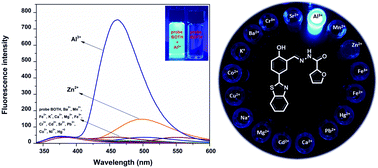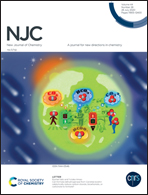A simple and sensitive fluorescent sensor platform for Al3+ sensing in aqueous media and monitoring through combined PET and ESIPT mechanisms: practical applications in drinking water and bio-imaging†
Abstract
In this study, a novel hydrazide-based compound, (E)-N′-(5-(benzo[d]thiazol-2-yl)-2-hydroxybenzylidene)furan-2-carbohydrazide (probe BOTH) was designed, characterized and prepared as a fluorogenic “turn-on” sensor for monitoring Al3+ in near-perfect aqueous media. All emission and absorbance spectral studies were performed in HEPES/DMSO (v/v, 99.95/0.05, pH = 7.0) media at 25 °C. The quantum yield of probe BOTH increases considerably in the presence of Al3+. Probe BOTH could sense Al3+ at a concentration as low as 6.47 nM. Probe BOTH could sense Al3+ with high sensitivity and selectivity, and a quantitative correlation of R2 = 0.9887 in the Al3+ concentration range of 0.0–20.0 equiv. To evaluate the method parameters, a validation study was performed based on different analytical parameters. The formation of complex BOTH–Al3+ (2 : 1 stoichiometry) was confirmed by 1H-NMR titration and MALDI-TOF MS, as well as Job's methods. pH-Dependent and Benesi–Hildebrand plot studies also supported this proposed sensing mechanism. Besides, the binding mechanism of Al3+ with probe BOTH was further verified by theoretical studies. Moreover, probe BOTH could be used for monitoring Al3+ in living-cells and water samples.



 Please wait while we load your content...
Please wait while we load your content...